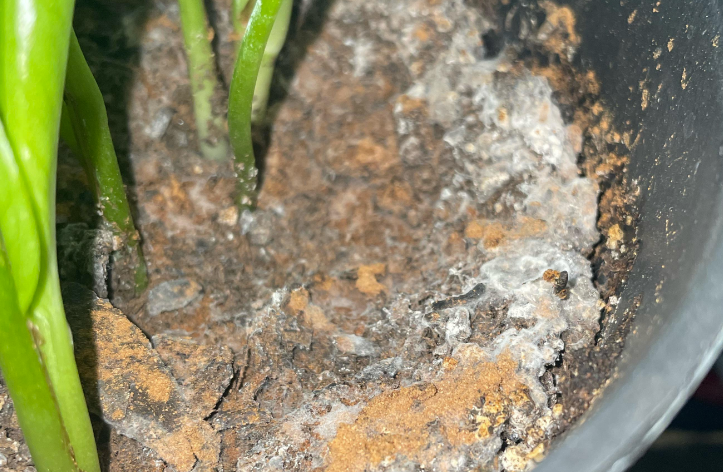Gray mold, or Botrytis, is a common fungal foe in the plant world, notorious for its ability to attack various plant types.
While it is rarely seen on semi-hydroponic plants, this relentless fungus can target any part of your plant, often leading to its demise. Characterized by a white or grayish coating, this mold will eventually turn plant areas brown as it progresses.

Why do my Plants have Gray Mold (Botrytis)?
This pesky mold thrives by dispersing spores either through water or air.
Its ideal breeding ground? A high-humidity environment rich in nutrients.
The initial infestation typically begins at a site of plant injury. A broken plant part reveals the essential nutrients gray mold needs to kickstart its growth.
This mold doesn’t just stop there; it’s known to rapidly spread to other plant areas.
High-risk areas include seedlings in damp conditions, wilting flowers, and plant cuttings.
Mold Identification Tips
Identifying gray mold early is key to protecting your semi-hydroponic garden. Look for these signs:
- Fuzzy Growth: Gray mold typically starts as a fuzzy, grayish-white coating on plant parts.
- Discoloration: Affected areas turn brown or black as the mold progresses.
- Soft Spots on Plants: Infected parts may feel soft or mushy.
- Wilting: Plants with gray mold often wilt rapidly.
- Distinctive Odor: A musty smell is sometimes noticeable around affected plants.
Regular inspections are vital. If you spot any of these signs, take immediate action to prevent further spread.
Effective Ways to Eliminate Gray Mold
The easiest way to remove gray mold is either:
- Mix some rubbing alcohol with water and use a spray bottle on the mold.
- Mix some hydrogen peroxide with water and use a spray bottle on the mold.
No worries, your plants will be totally fine!
Preventing Mold in Your Hydroponic System
Maintaining a mold-free semi-hydroponic requires diligent care and preventive strategies. Here are key practices to keep mold at bay:
- Regular Sterilization of Equipment: Cleanliness is crucial. Regularly sterilize all your semi-hydroponic equipment to prevent mold spores from taking hold.
- Manage Humidity and Ventilation: Excess humidity is a mold’s best friend. Ensure your grow area is well-ventilated to reduce moisture levels.
- Optimize Plant Spacing and Pruning: Avoid overcrowding your plants. Ensure there’s adequate airflow between them by spacing them out and trimming as necessary.
- Careful Handling of Cuttings: When taking plant cuttings, try to minimize exposure of the open areas of the plant, as these are vulnerable to mold spores.
- Remove Plant Debris Promptly: Any trimmings or dead plant matter should be removed from your semi-hydroponic garden immediately to prevent them from becoming breeding grounds for mold.
- Keep Plants Dry: Aim to keep your plants as dry as possible, especially the leaves and stems, as wet surfaces can invite mold growth.
For combating gray mold, consider these products:
- Fungicides: Products containing copper or sulfur can be effective. Always follow the manufacturer’s guidelines.
- Air Circulation Fans: Good air movement is essential. Invest in quality fans for your grow area.
- Hygrometers: Monitor humidity levels accurately with a reliable hygrometer.
Preventive Maintenance Schedule
A consistent maintenance schedule can significantly reduce the risk of gray mold. Here’s a simple checklist:
- Weekly:
- Inspect plants for signs of mold.
- Check and adjust nutrient levels.
- Clean and sterilize tools and equipment.
- Monthly:
- Deep clean system reservoirs.
- Replace any worn or damaged parts.
- Review plant spacing and adjust if necessary.
Role of Nutrient Solutions
The composition of nutrient solutions in your semi-hydroponic system can influence mold growth. High nitrogen levels, for example, can make plants more susceptible to mold. Consider these tips:
- Balanced Nutrients: Use a well-balanced nutrient solution that supports overall plant health.
- Regular Monitoring: Check nutrient levels regularly and adjust as needed to avoid imbalances.
- Clean Solutions: Change your nutrient solutions frequently to prevent the buildup of mold spores.
FAQ Section
Can gray mold spread to other plants?
Yes, gray mold can quickly spread to nearby plants. Immediate action is necessary to control its spread.
Is gray mold harmful to humans?
While not typically harmful to healthy individuals, it can cause allergic reactions in some people. Always wear protective gear when handling infected plants.

